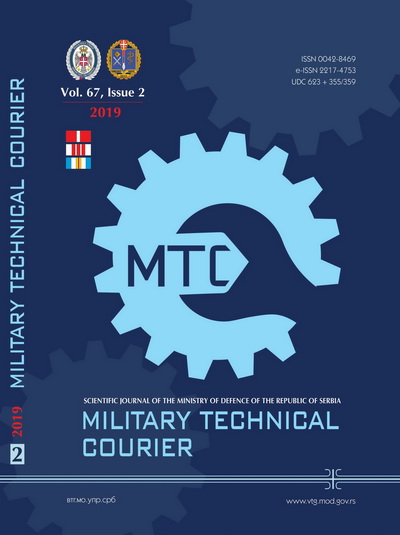Challenges of the implementation of the concept of flexible use of airspace in the Republic of Serbia
Abstract
The authors analyze the implementation of the concept of flexible use of airspace in the Republic of Serbia, which deals with problems related to airspace capacity. The problem of airspace capacity and air traffic that takes place in it was not seriously considered in Europe before the Second World War, due to the simple fact that the number of flights in that period was relatively small. Achieving this goal and solving the problem is being sought in a better organization of the airspace of Europe, which directly influences the organization and strategy of the development of the airspace of all countries in Europe and the Republic of Serbia (as a signatory and a member of international organizations dealing with traffic management and airspace organization ). The concept of flexible use of airspace should provide a solution to this problem. The implementation of the concept requires some legal and organizational solutions, so a wider national concept is needed for a consistent implementation of the concept. The problems encountered by the creators of the concept in Europe and Serbia and the solutions that have been made are the subject of this paper. The content of the paper is presented through several questions to give an overview of the problem of airspace capacity and an increase expected in the upcoming period. The paper also deals with the division of airspace in the world and in our country; planning, registering and announcing flights; the concept of flexible use of airspace; and the problems of applying the concept in Serbia.
References
-Civil Aviation Directorate of the Republic of Serbia. About the Civil Aviation Directorate. [Internet] Available at: http://cad.gov.rs/en/strana/16451. Accessed: 10.10.2018.
-Civil Aviation Directorate of the Republic of Serbia. Multilateralni sporazum o uspostavljanju zajedničkog evropskog vazduhoplovnog područja“ (ECAA sporazum). [Internet] Available at: http://www.cad.gov.rs/docs/onama/Multilateralni%20sporazum%2019.06.07.pdf (in Serbian). Accessed: 10.10.2018.
-Eurocontrol. Civil-Military. [Internet] Available at: https://www.eurocontrol.int/civil-military. Accessed: 10.10.2018.
-Eurocontrol. Flexibile Use of Airspace. [Internet] Available at: http://www.eurocontrol.int/articles/flexible-use-airspace. Accessed: 10.10.2018.
-Eurocontrol. 2003. Guidance document for the implementation of the FUA. [Internet] Available at: https://skybrary.aero/bookshelf/books/206.pdf. Accessed: 10.10.2018.
-Eurocontrol. What is the Single European Sky. [Internet] Available at: https://www.eurocontrol.int/dossiers/single-european-sky. Accessed: 10.10.2018.
-Federal Aviation Administration. Classes of Airspace. Types of Controlled Airspace. [Internet] Available at: https://www.faasafety.gov/gslac/alc/course_content.aspx?cID=42&sID=505&preview=true. Accessed: 10.10.2018.
Hallgren, A. 2009. Annual Report on the Implementation of FUA. In The European Experience FUA. Available at: https://www.icao.int/EURNAT/Other%20Meetings%20Seminars%20and%20Workshops/FUA%20Workshops/Flexible%20Use%20of%20Airspace%20-%20Demystified/1-2-1%20civ%20perspective.pdf. Accessed: 10.10.2018.
-International Civil Aviation Organization. 2006. Convention on International Civil Aviation. Part I, Chapter I, Article 1, Doc 7300/9, Ninth Edition, p.2.
Official Journal of the European Union. 2005. Commission regulation (EC) No 2150/2005, 24. December, pp.L342/20-25. Available at: http://eur-lex.europa.eu/LexUriServ/LexUriServ.do?uri=OJ:L:2005:342:0020:0025:EN:PDF
Pečenković, D. 2008. Statistički podaci o iskorišćenosti zone TSA-01.Agencija za kontrolu letenja SMATSA (in Serbian).
-Skybrary. Classification of Airspace. [Internet] Available at: https://www.skybrary.aero/index.php/Classification_of_Airspace. Accessed: 10.10.2018.
Službeni glasnik RS. 69/2011. Pravilnik o preuzimanju propisa Evropske unije o upravljanju vazdušnim prostorom i fleksibilnom korišćenju vazdušnog prostora. Belgrade: JP „Službeni glasnik“ (in Serbian).
Službeni glasnik RS. 106/2013. Uredba o FCasama vazdušnog prostora Republike Srbije i uslovima za njihovo korišćenje. Belgrade: JP „Službeni glasnik“. Available at: https://www.mgsi.gov.rs/sites/default/files/Zakon%20o%20vazdu%C5%A1nom%20saobra%C4%87aju.pdf (in Serbian). Accessed: 10.10.2018.
Službeni glasnik RS. 8/2014. ZaFCjučak o utvrđivanju nacionalne politike upravljanja vazdušnim prostorom Republike Srbije. Belgrade: JP „Službeni glasnik“. Available at: http://demo.paragraf.rs/demo/combined/Old/t/t2014_01/t01_0451.htm (in Serbian). Accessed: 10.10.2018.
Službeni glasnik RS. 66/2015. Zakon o vazdušnom saobraćaju, član 4. Belgrade: JP „Službeni glasnik“. Available at: https://www.mgsi.gov.rs/sites/default/files/Zakon%20o%20vazdu%C5%A1nom%20saobra%C4%87aju.pdf (in Serbian). Accessed: 10.10.2018.
Službeni vojni list. 14/2018. Pravilnik o letenju vojnih vazduhoplova. Belgrade: Ministarstvo odbrane Republike Srbije (in Serbian).
-SMATSA. 2008. Uputstvo za planiranje, najavu, prijavu i obezbeđenje letova vojnih i civilnih vazduhoplova.Belgrade (in Serbian)
-SMATSA. General overview. [Internet] Available at: http://www.SMATSA.rs/Eng/ShowContent.aspx?mi=11. Accessed: 10.10.2018.
-SMATSA. Karta nižeg sloja vazdušnih puteva u R.Srbiji (in Serbian).
Stanković, V., & Petošević, V. 2012. Control and protection of the Serbian airspace. Vojnotehnički glasnik/Military Technical Courier, 60(4), pp.211-229. Available at: https://doi.org/10.5937/vojtehg1204211S (in Serbian).
-Vojnoizdavački zavod. 1981. Vojni leksikon.Belgrade: Vojnoizdavački zavod (in Serbian).
Proposed Creative Commons Copyright Notices
Proposed Policy for Military Technical Courier (Journals That Offer Open Access)
Authors who publish with this journal agree to the following terms:
Authors retain copyright and grant the journal right of first publication with the work simultaneously licensed under a Creative Commons Attribution License that allows others to share the work with an acknowledgement of the work's authorship and initial publication in this journal.
- Authors are able to enter into separate, additional contractual arrangements for the non-exclusive distribution of the journal's published version of the work (e.g., post it to an institutional repository or publish it in a book), with an acknowledgement of its initial publication in this journal.
- Authors are permitted and encouraged to post their work online (e.g., in institutional repositories or on their website) prior to and during the submission process, as it can lead to productive exchanges, as well as earlier and greater citation of published work (See The Effect of Open Access).

